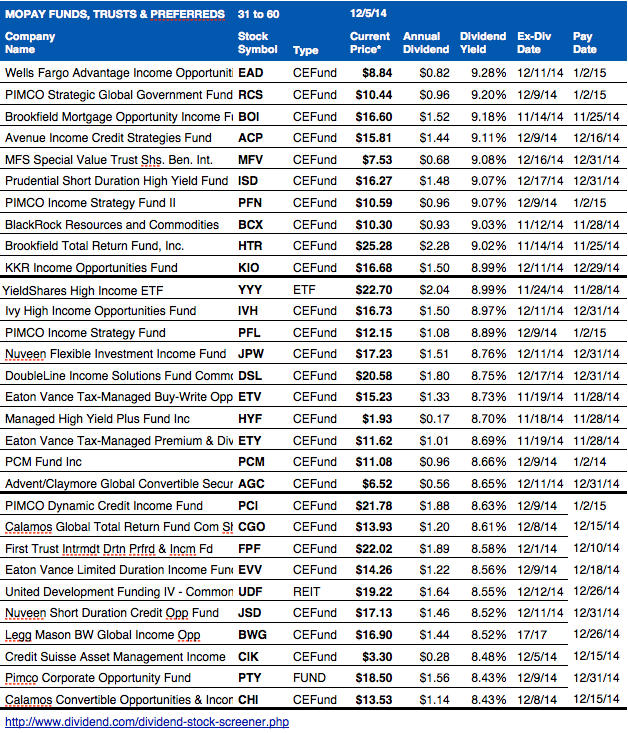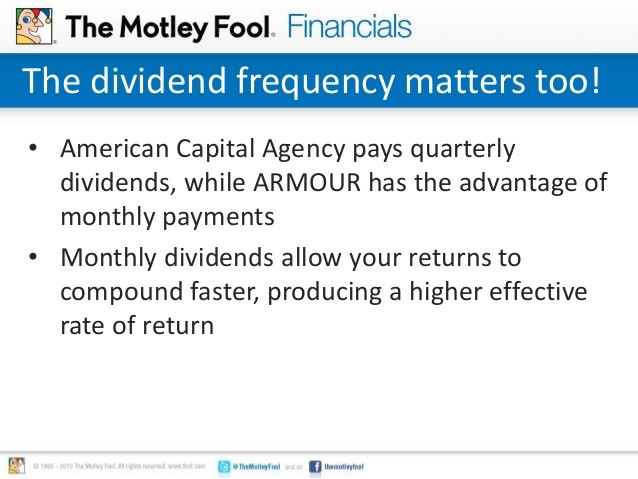12 REITs That Pay Monthly Dividends And 1 Great One That Does Too
Post on: 22 Май, 2015 No Comment

I always get this question: What is the most important metric you rely upon for REIT investing? My answer, of course, is that a dividend increase provides the best possible evidence of safety and I sleep well at night when I see a dividend that’s just been raised.
That one metric provides me with a considerable amount of data and the most important piece of the news is the most important commitment by the company to shareholders — that speaks plainly that management is strongly committed to increasing the dividend that shareholders are counting on.
A dividend increase also sends a message that the company’s earnings stream can be relied upon and that the underlying business model is sustainable. In the Ultimate Dividend Playbook . the author, Josh Peters, sums up the signal inherent with a stock that increases its dividend over time:
Durability implies that the firm can take a financial punch in one year and come back swinging the next.
Although not the only metric, I consider a consistent dividend increase to be a primary ingredient in my SWAN (sleep well at night) portfolio in my monthly newsletter. There are many other metrics that I research and evaluate; however, most are tied to the same common thread of the dividend payment — the ultimate sign of corporate strength.
One way to hedge against inflation is to focus on stocks that are likely to boost their dividends on a regular basis. Inflation can reap havoc to an investment strategy and one way to stave off the effects of inflation is to make sure your portfolio includes companies with a pattern of boosting dividends.
Alternatively, many income investors are looking for monthly dividend payments to support their income during retirement. By investing in REITs that pay monthly you’re able to better match fund your living expenses and create a more disciplined approach to saving and investing. Many retirees (and even students) like receiving monthly rewards (in the form of dividends) as they provide me the flexibility of paying a household bill, enjoy a round of golf, or eating out at a favorite restaurant.
Others, like me, simply enjoy putting their money back to work — like owning a free share machine. Many pre-retirement investors want monthly dividend stocks for their IRAs for faster compounding. The longer you hold your shares, the higher the yield you will receive on your original investment and the greater the impact of the cumulative dividend effect.
That cumulative dividend effect means that the longer you own your shares, the less remaining original principal you have invested in the company. These combined benefits are only available with companies that pay reliable dividends that are regularly increased over time.
REITs Are Much Better Than Rentals
More and more REITs are now paying monthly dividends. The logic is simple: Retail investors enjoy the benefits of owning shares that make bill paying easy. However, the benefits don’t end there.
Companies that pay quarterly (or semi-annually) almost always announce the payment of their next dividend payment at the time of the payment period. However, companies that pay monthly provide more frequent communication (to investors) and if the company increases, reduces, or suspends a payment, the shareholder can move quicker to react to the good or bad news.
Another advantage is that investors like me who reinvest dividends will return almost 1% more yearly than quarterly payors. That’s due to the laws of compounding. As Marc Lichtenfeld explains in Get Rich with Dividends :
Compounding takes a while to get started, but once it does, it’s like a runway train going downhill, picking up momentum each year.
Lichtenfeld went on to explain:
If you’re an investor who doesn’t need the income right now and can put off instant gratification for long-term benefits, reinvesting your dividends can generate the kinds of returns you probably thought were possible.
One of the best things that I enjoyed while owning commercial real estate was collecting rent checks. A few years back I owned around 20 duplexes and although some of the properties were mortgaged, I had a rush every month that I went door to door to collect the rent. Most of my tenants paid me in cash and it was extremely rewarding to deposit a wad of cash in the bank.
Of course I couldn’t keep the cash. After paying the mortgage, taxes, insurance, and frequent repairs, I ended up with beer money.
However, the feeling I get today — owning high quality real estate (in the form of REITs) with monthly income (and no expenses to pay) — is incredible. My learning curve taught me a lot and my biggest lesson was that I’m much better at hiring an experienced management team being a weekend handyman. By owning REITs I get a much more reliable source of income and I don’t have to worry about the 3 T’s — Toilets, Trash, or Taxes.
13 REITs That Pay Monthly
Besides having professional management, there are many other reasons that I prefer REITs to Rentals, the most essential being liquidity and diversification.
Liquidity is simple. I can get my money back at anytime. REITs are publicly traded and that means that there are buyers and sellers 24 hours a day.
In terms of diversification, there are over 140 US equity REITs and around 36 mortgage REITs. Instead of owning 20 duplexes in one town, I can invest in 5 REITs that own properties in 50 states. There is really no limit to diversification and the number of sub-sectors is increasing every year.
In terms of REITs that pay monthly, I have included a list of 13 companies. Although all of these REITs do pay monthly, I would not necessarily recommend that you buy all of them. For simplicity, I have classified these REITs in 3 buckets: BUY, SELL, and HOLD.
The list of REITs that pay monthly include American Realty Capital Properties (NASDAQ:ARCP ), Armour Residential (NYSE:ARR ), Chatham Lodging Trust (NYSE:CLDT ), Chambers Street (NYSE:CSG ), EPR Properties (NYSE:EPR ), Gladstone Commercial (NASDAQ:GOOD ), Gladstone Land (NASDAQ:LAND ), Inland Real Estate (NYSE:IRC ), LTC Properties (NYSE:LTC ), Realty Income (NYSE:O ), STAG Industrial (NYSE:STAG ), Wheeler Real Estate (NASDAQ:WHLR ), and Whitestone Real Estate (NYSE:WSR ).
Starting with the SELL bucket is Armour Residential. On September 18th the REIT disclosed the monthly cash dividend rate for the company’s common stock of 5 cents per share for the fourth quarter, a decrease from its previous dividend of 7 cents per share.
Also, both Gladstone REITs are on my SELL list and to learn more about Gladstone Commercial, check out my latest article HERE. I’m also including Wheeler on my SELL list. It’s clear that the company has a very high dividend yield of 9.72%; however, I’m not confident that the company can sustain it and the credit quality and tertiary market strategy doesn’t rest well with me. With the exception of Gladstone Land, all of these REITs appear to be attractive from a yield perspective, but I don’t consider them safe (based on my standards).
The next bucket is the HOLD category. American Realty Capital Properties has been an amazing REIT, primarily fueled by non-traded REIT investors, financial planners, and hedge funds. I’m not sure that the dividend is sustainable and I have decided to maintain a neutral position in this REIT until the dust settles with the recent Cole Real Estate (NYSE:COLE ) merger .

EPR Properties has done an excellent job since it cut its dividend in 2010. I believe the continued diversification into non-cinema related assets is helping to grow confidence as well as the company’s prudent capital management. However, I believe there are better Triple Net REITs that provide better risk-adjusted returns.
LTC Properties has also clawed back its entire dividend cut in 2009; however, I see more compelling opportunities with Omega Healthcare Investors (NYSE:OHI ) and although Omega doesn’t produce a monthly reward, I believe it’s a better option for me. (See my article on LTC HERE and my article on OHI HERE ).
Finally, Whitestone throws off an 8.1% dividend and the highest yield in the shopping center sector. However, I have a similar concern with asset quality and the frequency in dividend cuts over the years. That’s what Josh Peters (in The Ultimate Dividend Playbook ) refers to as a sucker-yield stock. (see my article on WSR HERE ).
Now, saving the best from last is the BUY bucket with 5 REITs. These more sustainable brands all share the common attribute that I spoke of at the beginning of this article — they all provide a more durable dividend component.
These REITs are as follows (in no random order): Chatham Lodging Trust, Chambers Street, Inland Real Estate, Realty Income, and STAG Industrial. I would say that from a valuation perspective, Chambers Street is the cheapest (with a P/FFO of 12.4x); however, Realty Income has the best track record of paying dividends with over 19 years in a row of dividends paid and increased.
(click to enlarge) I guess that I just answered my second most asked question: What is your favorite REIT today? With a name like The Monthly Dividend Company Realty Income has become a trademark REIT built on the power of repeatable sources of income. That differentiation is also the prime source of competitive advantage and the primary attribute that separates the good from the great.
I was attending an event in Miami a few weeks ago and Gary Player was there. That reminded me of a quote I heard from Player a few years ago and it seems to be fitting for the close of this article. Player said,
Greatness is Talent Applied Consistently.
Yes, Realty Income is a Great REIT That Happens to Also Pay Monthly Dividends. I own it and I will continue to reinvest my dividends until one day, I will have a wad of cash that will allow me to live off of. Then, I will just sit around writing Seeking Alpha articles on my laptop waiting on my monthly dividend checks.
But for now, I’ll let the power of compounding work for me so its off to bed. and while I’m sleeping well at night my divided checks are working hard — day and night!
My REIT Newsletter. Only $99 a year. Subscribe HERE .
Source. FastGraphs, SNL Financial, and NAREIT.
Disclaimer: This article is intended to provide information to interested parties. As I have no knowledge of individual investor circumstances, goals, and/or portfolio concentration or diversification, readers are expected to complete their own due diligence before purchasing any stocks mentioned or recommended.
Disclosure: I am long O, DLR, VTR, HTA, STAG, UMH, CSG, GPT, ARCP, ROIC, MPW, HCN, OHI, LXP, KIM. I wrote this article myself, and it expresses my own opinions. I am not receiving compensation for it (other than from Seeking Alpha). I have no business relationship with any company whose stock is mentioned in this article.














